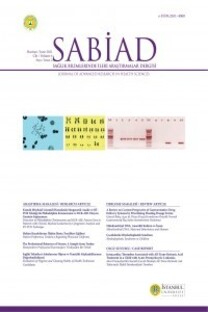Sendromik Olmayan Microtia ve Glucocorticoid Receptor Genindeki BCL1 Variantının İlişkisi
Microtia, DNA, glukokortikoid reseptör, BCL1, varyant
The Relationship Between the BCL1 Variant of the Glucocorticoid Receptor Gene and Non-Syndromic Microtia
Microtia, DNA, glucocorticoid receptor, BCL1, variant,
___
- 1. Alasti F, Van Camp G. Genetics of Microtia and Associated Syndromes. J Med Genet. 2009;46(6): 361-69 .
- 2. Luquetti DV, Heike CL, Hing AV, Cunningham ML, Cox TC. Microtia: Epidemiology & Genetics. Am J Med Genet A. 2012;158A(1): 124-39.
- 3. McEwen BS. Physiology and neurobiology of stress and adaptation: central role of the brain. Physiol Rev. 2007;87(3):873-904.
- 4. Korgun ET, Ozmen A, Unek G, Mendilcioglu I. The Effects of Glucocorticoids on Fetal and Placental Development. X Qian (Ed.), Glucocorticoids – New Recognition of Our Familiar Friend, InTech, Croatia 2012; 305-36.
- 5. El-Fayoumi R, Hagras M, Abozenadaha A, Bawazir W, Shinawi T. Association Between NR3C1 Gene Polymorphisms and Toxicity Induced by Glucocorticoids Therapy in Saudi Children with Acute Lymphoblastic Leukemia. Asian Pac J Cancer Prev. 2018; 19(5): 1415-23.
- 6. Fleury I, Beaulieu P, Primeau M, Labuda D, Sinnett D, Krajinovic M. Characterization of the BclI polymorphism in the glucocorticoid receptor gene. Clin Chem. 2003;49:1528-31.
- 7. Miller SA, Dykes DD, Polesky HF. A simple salting out procedure for extracting DNA from human nucleated cells. Nucleic Acids Res. 1988;16:1215.
- 8. Aydeniz A, Sever T, Pehlivan S, Pehlivan M, Altındag O, Budeyri S, Gursoy S. Investigation of Glucocorticoid Receptor Gene Bcl-1 Polymorphism in Rheumatoid Arthritis. Turk J Rheumatol 2011;26(3):199-203.
- 9. Ruimin Qiao, Yuyong He, Bo Pan, Shijun Xiao, Xufei Zhang, Jing Li, Zhiyan Zhang, Yuan Hong, Understanding the molecular mechanisms of human microtia via a pig model of HOXA1 syndrom. Disease Models & Mechanisms 2015;8:611-22.
- 10. Gendron C, Schwentker A, van Aalst JA. Genetic Advances in the Understanding of Microtia. J Pediatr Genet. 2016; 5(4):189-97.
- 11. Bromer C, Marsit CJ, Armstrong DA, Padbury JF, Lester B. Genetic and epigenetic variation of the glucocorticoid receptor (NR3C1 ) in placenta and infant neurobehavior. Developmental Psychobiology 2013;55(7):673-83.
- 12. Timmermans S, Souffriau J, Libert C. A General Introduction to Glucocorticoid Biology. Front Immunol. 2019;10:1545.
- 13. Mangelsdorf DJ, Thummel C, Beato M, Herrlich P, Schütz G, Umesono K, Blumberg B, Kastner P, Mark M. The nuclear receptor superfamily: the second decade. Cell. 1995; 83:835-39.
- 14. Wust S, Federenko IS, van Rossum EF, Koper JW, Kumsta R, Entringer S, Hellhammer DH. A psychobiological perspective on genetic determinants of hypothalamus-pituitary-adrenal axis activity. Ann N Y Acad Sci. 2004;1032:52-62.
- 15. Srivastava N, Prakash J, Lakhan R, Agarwal CG, Pant DC, Mittal B. Influence of Bcl-1 Gene Polymorphism of Glucocorticoid Receptor Gene (NR3C1, rs41423247) on Blood Pressure, Glucose in Northern Indians. Indian J Clin Biochem. 2011;26(2):125-30.
- 16. van Rossum EF, Koper JW, van den Beld AW, Uitterlinden AG, Arp P, Ester W, et al. Identification of the BclI polymorphism in the glucocorticoid receptor gene: association with sensitivity to glucocorticoids in vivo and body mass index. Clin Endocrinol (Oxf). 2003;59(5):585-92.
- 17. Szappanos A, Patócs A, Töke J, Boyle B, Sereg M, Majnik J, Borgulya G, Varga I, Likó I, Rácz K, Tóth M. BclI polymorphism of the glucocorticoid receptor gene is associated with decreased bone mineral density in patients with endogenous hypercortisolism. Clin Endocrinol (Oxf). 2009;71(5):636-43.
- Yayın Aralığı: Yılda 3 Sayı
- Başlangıç: 2018
- Yayıncı: İstanbul Üniversitesi
Role of CYP3A4*1B gene variant in substance use disorder
Gazi ÇAPAR, Hayriye ŞENTÜRK ÇİFTÇİ, Sacide PEHLİVAN
Multiple Miyelom Hastalarında Nötrofil Lenfosit Oranının Prognostik Önemi
Alpay MEDETALİBEYOĞLU, Nur AKYÜZ, Sena BAYRAKDAR, Mustafa ALTINKAYNAK, Timur AKPINAR, Cemil TAŞÇIOĞLU
Statik Manyetik Alanın Trombosit Agregasyonuna Etkisi
Çiğdem GÜREL, Gulsel AYAZ, Handan TUNCEL, Mustafa Tunaya KALKAN, Nazmiye KURŞUN, Turgut ULUTİN
Çocukluk Çağı T-ALL Hastalarında PTEN ve AKT1 Gen Anlatım Düzeyleri
Fulya KÜÇÜKCANKURT, Özden HATIRNAZ NG, Müge SAYİTOĞLU, Yücel ERBİLGİN
Ahmet GÖKSU, Hilal HEKİMOĞLU, Selçuk SÖZER TOKDEMİR
Cerrahi Kliniklerinde Yatan Hastaların Anksiyete ve Depresyon Düzeylerinin Belirlenmesi
Sendromik Olmayan Microtia ve Glucocorticoid Receptor Genindeki BCL1 Variantının İlişkisi
Ayşe Feyda NURSAL, Kürşat ÖZDİLLİ, Mehmet BEKERECİOĞLU, Berker BÜYÜKGÜRAL, Sacide PEHLİVAN
Selin COŞKUN, Şükriye YILMAZ, Ayşe ÇIRAKOĞLU, R. Dilhan KURU, Yelda TARKAN ARGÜDEN, Şeniz ÖNGÖREN, Seniha HACIHANEFİOĞLU
Multiple Myeloma Hastalarında Sitokin Gen Polimorfizmleri ve Kromozom 13 Delesyonu
Çiğdem KEKİK, Gonca KARAHAN, Sonay TEMURHAN, Sevgi KALAYOĞLU BEŞIŞIK, Fatma Savran OĞUZ, Filiz AYDIN
